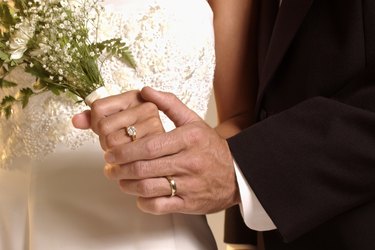
A handfasting ceremony is an ancient Pagan custom practiced by Celts before they adopted the Christian religions. In the ceremony, a couple's wrists are symbolically tied together with a handfasting cord. Traditionally, a handfasting was a trial marriage lasting a year and a day after which a couple could decide to go their separate ways or make the marriage permanent. Today, many modern pagans incorporate handfasting as the main ceremonial element in addition to, or in place of the exchange of rings. The ceremony represents literally tying the knot
Gather the Materials
Video of the Day
The cord consists of three 6-foot sections of material braided together. A variety of materials can be used for the cord itself. Satin ribbon, colorful yarn, drapery cording or rat-tail cord represent good choices easy to find. You can include strands of embroidery floss, metallic thread or bead strands to add color and interest. The finished cord should be long enough to loop over both wrists and then easily tied into a knot. You can also add charms that have special meaning to the couple, beads large enough to easily thread on the cord ends and tassels.
Video of the Day
Making the Cord
Evenly gather the ends of the three cords and tie a knot leaving a 4- to 5-inch tail. Loosely braid the three sections together by crossing the right cord over the center cord and then the left cord over then center cord, repeating these steps and stopping 4 to 5 inches from the opposite end. Tie a knot at the end to secure the braid. Trim both ends of the braid to match. Next thread desired charms and beads onto the cord ends, leaving enough room to tie a knot to hold them in place.
Create a Binding Cloth
A binding cloth offers an alternative to the handfasting cord, but is made and used in the same way. Choose a cloth that is approximately 2 1/2 to 3-inches wide and 3- to 5-feet long. Use a traditional tartan plaid that represents the groom's clan. Fabric choice is a matter of personal preference, so choose one that works with the wedding colors or a color that has special meaning to the couple. Hand-sew tassels and charms onto the narrow ends of the cloth. Symbols like runes could be embroidered along the length to add meaning for the couple. Turn edges under by machine or hand sewing to give the handfasted cloth a more finished look.
Other Considerations
A handfasting cord is a very symbolic and personal element of a ceremony, so there is no right or wrong way to use one. You can also use a beautiful silk scarf 3 to 5 feet long as a binding cloth. Incorporate cord colors that have special meanings such as white for purity, green for fertility and growth or red for passion. Have a fabric pouch or a decorative box to hold the cords after the ceremony.
- Offbeat Bride: How to Make Handfasting Cords
- Reverand Su Windsong: Handfastings 101
- Handfastings.org: What is a Handfasting?
- Religious Tolerance: Celtic/Neopagan Handfasting
- Vows of the Heart: Handfasting Wedding Ceremony
- Handfasting and Wedding Rituals: Welcoming Hera's Blessing; Raven Caldera & Tannin Schwartzstein